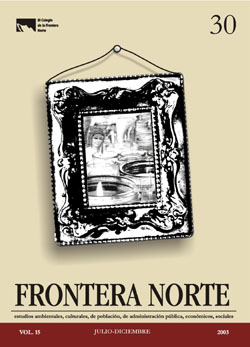Evolución del empleo fronterizo en los noventa: Efectos del TLCAN y de la devaluación sobre la estructura ocupacional.
Main Article Content
Abstract
Article Details
Authors publishing work in this journal agree to the following conditions:
Authors retain copyright and assign first publication rights to the journal Frontera Norte (RFN), with the texts registered under an Attribution-NonCommercial-NoDerivatives 4.0 International Creative Commons license (CC BY-NC-ND 4.0), which allows third parties to use published material provided they give credit to the authors and acknowledge this journal as the first publisher.
They authorize the reproduction, publication, translation, communication, and transmission of their paper and all accompanying material, publicly and in any form and by any means; its public distribution in as many copies as required; and public communication thereof in any form, including making it available to the public through electronic means or any other technology, and solely for dissemination and scientific, cultural, and non-commercial purposes.
Authors may enter into further independent contractual agreements for the non-exclusive distribution of the version of the paper published in this journal (for instance, to include it in an institutional repository or personal webpage, or publish it in a book), provided it is not for commercial purposes and they clearly state that the work was first published in Frontera Norte (RFN) [and add the corresponding bibliographical record: Author/s (Year). Title of paper. Frontera Norte, volume (number), pp. doi: xxxx].
To that end, authors must submit the form assigning ownership of first publication rights, duly completed and signed. This document is to be uploaded in PDF format as a complementary file on the OJS platform.
This work is released under an Attribution-NonCommercial-NoDerivatives 4.0 International Creative Commons license (CC BY-NC-ND 4.0)..
References
Alegría, Tito, Desarrollo urbano en la frontera México Estados Unidos. Una interpretación algunos resultados Consejo Nacional para la Cultura y las Artes, México, 1992, 285 pp.
____, "Efectos de la industria maquiladora en el empleo urbano", Comercio exterior, vol. 45, núm 10, octubre de 1995, pp. 746-755.
____, "Demand and Supply among Mexican Cross-Border Workers", Journal of Borderlands
Studies, vol. 17, num. 1, primavera de 2002.
Alonso, Jorge, Jorge Carrillo y Oscar Contreras, 'Aprendizaje tecnológico en las maquiladoras del norte de Mexico", Frontera norte, vol. 14, num. 27, enero-junio de 2002, pp. 43-82.
Browning, Harley y Rene Zenteno, "The Diverse Nature of the Mexican Northern Border: The Case of Urban Employment", Frontera nor/e, vol. 5, núm. 9, enero-junio de 1993, pp.11-31.
Carranza, Mario, "Neighbors or Partners? NAFTA and the Politics of Regional Economic Integration in North America", Critical Debates Latin American Politics and Society, vol. 44, núm. 3, otoño de 2002, pp. 141-157.
Carrillo, Jorge y Alfredo Hualde, "Maquiladoras de tercera generación. El caso de Delphy General Motors", Comercio exterior, vol. 47, núm. 9, septiembre de 1997,pp. 747-758.
Castells, Manuel y Alejandro Portes, "El mundo debajo: Orígenes, dinámica y efectos de la economía informal", en Tokman (comp.), EI sector informal en America Latina. Dos décadas de análisis, México, Consejo Nacional para la Cultura y las Artes, 1991, pp. 233-272.
Centro de Investigación para el Desarrollo, EI Acuerdo de Libre Comercio México- Estados Unidos, México, Diana, 1991.
Comisión Económica para America Latina, "El regionalismo abierto en America Latina y el Caribe: La integración económica al servicio de la transformación productiva con equidad", Cincuenta años de pensamiento en Ia CEPAL., Fondo de Cultura Económica y CEPAL1, 998, pp. 903-923 (textos Seleccionados, vol. II).
____, La inversión extranjera en America Latina y el Caribe. Informe 1999, Naciones Unidas, 2000,220 pp.
Gruben, William, "Was NAFTA Behind Mexico's High Maquiladora Growth?” Economic and Financial Review, tercer trimestre, 2001, pp. 11-21.
Instituto Nacional de Estadística, Geografía e Informática, Estadísticas económicas, indicadores de empleo y desempleo, Aguascalientes, agosto de 1998, 284 pp.
Krugman, Paul, "The Uncomfortable Truth about NAFTA. It's Foreign Policy, Stupid", Foreign Affairs, noviembre-diciembre de 1993, pp. 13-19.
Peach, James y Richard Adkisson, "NAFTA and Economic Activity Along the US-Mexico Border", Journal of Economic Issues vol. XXXIV, núm. 2, junio de 2000,pp. 481-489.
Rendón, Teresa y Carlos Salas, "El empleo en México en los ochenta: Tendencias y cambios", Comercio exterior, vol. 43, núm. 8, agosto de 1993, pp. 717-730.
___Ajuste estructural y empleo: EI caso México", Revista latinoamericana en estudios del trabajo, ano 2, num.2, 1996, pp. 77-103.
Roberts, Bryan, "Enterprise and Labor Markets: The Border and the Metropolitan Áreas", Frontera norte, vol. 5, núm. 9, enero-junio de 1993, pp. 33-65.
Roubaud, Francois, La economía Informal en México. De la esfera doméstica a la dinámica macroeconómica, México, .Fondo de Cultura Econ6mica, INEGI, ORSTOM, 1995,484 pp.
Salas, Carlos, "Mexico's Haves and Have-Nots: NAFTA Sharpens the Divide", NACLA Report on the Americas, vol. XXXV, núm. 4, enero-febrero de 2002, pp. 32-45.
Thorbecke, Willeni y Christian Eigen-Zucchi, "Did NAFTA Cause a 'Giant Sucking Sound'?", Journal of Labor Researchv, ol. XXIII, num. 4, otoño de 2002, pp.647-658.
Weintraub, Sidney, "EI debate sobre el libre comercio en America del Norte", en Vega Gustavo (coord.), México ante el libre comercio con America del Norte, México, EI Colegio de México y Universidad Tecnol6gica de México, pp.145-165.
Zenteno, Rene, On Depicting Local Labor Markets in Mexico: The Structure of Employment Conditions in Tijuana and Ciudad Juarez, Phd., Austin, The University of Texas, 1995,230 pp.
____, "Un marco analítico para el estudio de las condiciones del empleo urbano en la frontera norte de México", Estudios demográficos y urbanos vol. 10, número 3, 1995, pp. 491-522.
_____, "Crisis econ6mica y determinantes de la oferta de trabajo femenino en México: 1994-1995", Estudios demográficos y urbanos, vol. 14, num. 2,1999, pp.353-381.

